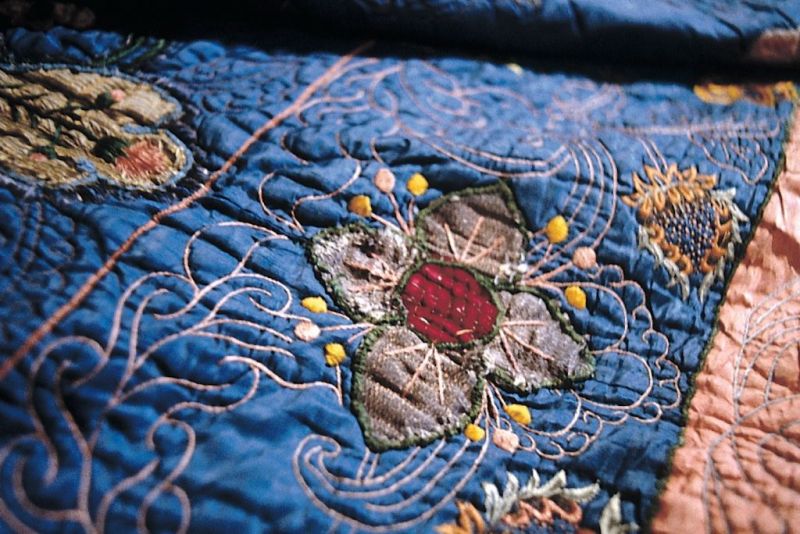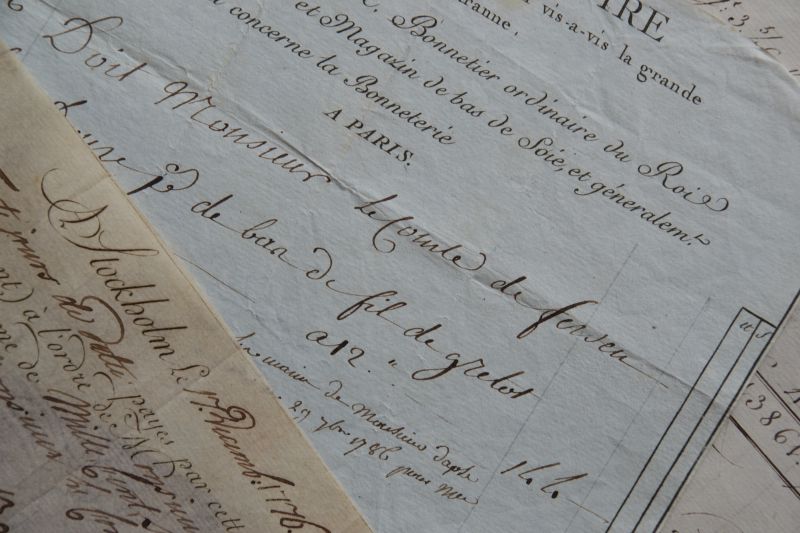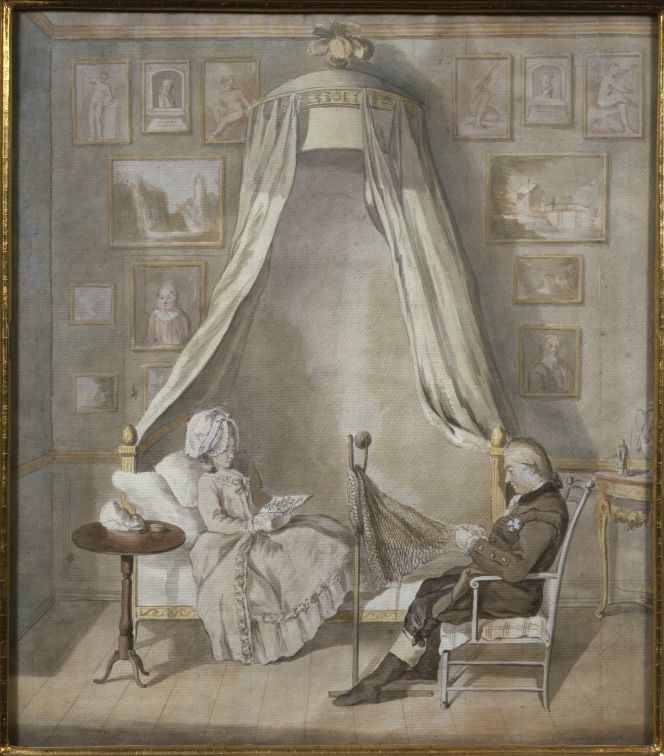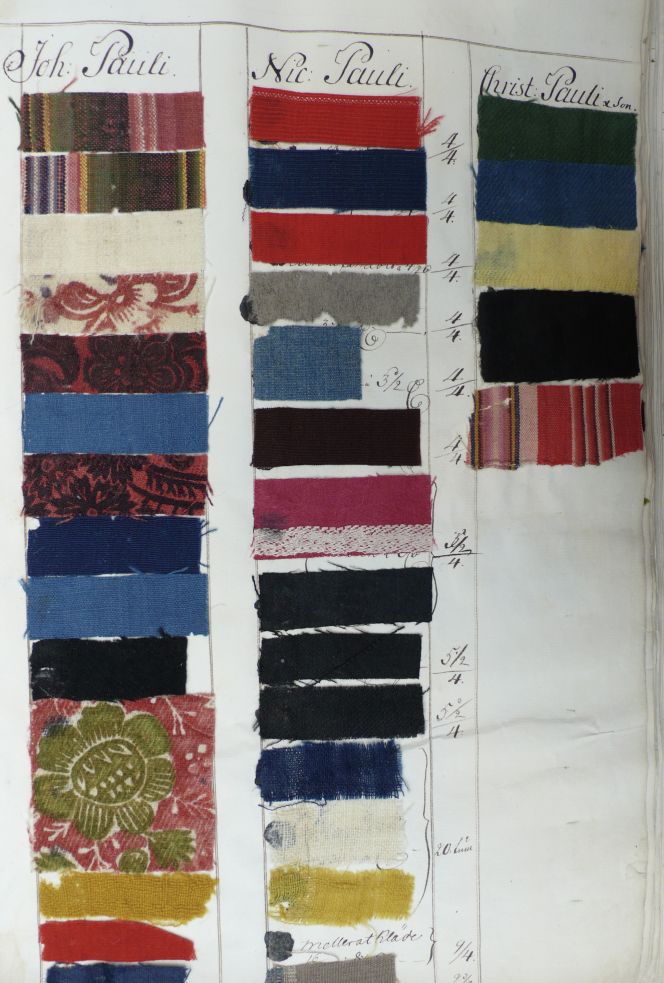ikfoundation.org
The IK Foundation
Promoting Natural & Cultural History
Since 1988


BEDS, BED-CURTAINS AND BEDCOVERS
– at a Manor House in 1758
In the mid-18th century, the bedchambers in wealthy Swedish manor houses were still used as representative rooms, a welcoming space for invited guests and visitors. The textile splendour was stated on the four-poster beds and similar models with harmonising fabrics, valances, ribbons, tassels and other accessories. This essay – based on items listed in an inventory from a grand manor house – will give a detailed account of such materials that are used. Recorded as quilted bedcovers, striped linens, silk damasks and brocades, comfortable, warm woollen fabrics, a great variation of fashionable cotton and printed calicoes, silk bed curtains with fitted cords and much more. Together with a few historical traces of bed-cupboards and wall beds used in the servant areas.
 This quilted silk bedcover – with rich silk embroidery – is a typical example of textile furnishing that could have been used at Christinehof manor house in 1758. Silks of various designs and qualities seem to have been preferred in many rooms, judging by the listed bedcovers and bed curtains of the Inventory. (Collection: Malmö Museum, MM 52381) Photo: The IK Foundation, London.
This quilted silk bedcover – with rich silk embroidery – is a typical example of textile furnishing that could have been used at Christinehof manor house in 1758. Silks of various designs and qualities seem to have been preferred in many rooms, judging by the listed bedcovers and bed curtains of the Inventory. (Collection: Malmö Museum, MM 52381) Photo: The IK Foundation, London.The most common model in the manor house was the four-poster beds (12) with curtains, which seem to have been used by members of the aristocratic Piper family, in guest rooms as well as by the most prominent servants. This bed type was more or less luxurious, depending on the chosen textile materials. The listed bedcovers were primarily a decorative feature, sometimes mentioned as old. For instance, in the chamber of the family priest on the ground floor, the bed had ‘blue and white linen curtains, edged with red ribbons’ and ‘1 old cotton bedcover’. The housekeeper’s bed on the same floor had ‘yellow and white linen diaper curtains edged with white ribbons’ and ‘1 red patterned bedcover with yellow linen lining’.
The textiles for the four-poster beds listed on the first and second floors were, in general, of more costly materials. Here are a few examples:
- In the Young Lady’s Chamber: ‘Four-poster bed of blue and white Parcum linen with painted knobs and quilted bedcover of the same fabric’.
- In the Blue Wing Chamber: ‘…with blue and white gauzy fabric’ and ‘printed calico bedcover’.
- In Count Törnflycht’s Chamber: ‘…of green and white gauzy linen for canopy and valance’ and ‘1 red silk bedcover with green silk border’.
- Baron Unger’s Chamber listed an unusually detailed description, including fabrics re-used from an old garment: ‘…with a canopy of red and white [woven or printed] flowery patterned fabric and a green moire with white silk cords edged and lined with green [Bast], named the Stockholm Bed, made of the Countess’ gown/clothing’ and ‘1 bedcover of green and white silk taffeta and red silk chintz as a panel at the centre’.
 Various 18th century recipes/accounts: food, wine and fabrics from Paris, wine glasses from London etc kept in the Piper Family Archive give a glimpse of the family members’ direct contacts with other European countries during Grand Tours and other travels. Purchases of desired fine fabrics were often included – possible to be used for clothing and interior furnishing alike. (Collection: Historical Archive of Högestad and Christinehof, Piper Family Archive: C.G. Piper 1775-86, F/III 1, 15). Photo: The IK Foundation, London.
Various 18th century recipes/accounts: food, wine and fabrics from Paris, wine glasses from London etc kept in the Piper Family Archive give a glimpse of the family members’ direct contacts with other European countries during Grand Tours and other travels. Purchases of desired fine fabrics were often included – possible to be used for clothing and interior furnishing alike. (Collection: Historical Archive of Högestad and Christinehof, Piper Family Archive: C.G. Piper 1775-86, F/III 1, 15). Photo: The IK Foundation, London.The most impressive model in use at Christinehof in 1758 was the ‘Imperial bed’ (3) – which gave an opportunity to show off luxurious fabrics and state the family’s high station in life. One such piece was placed in the Countess’ Bedchamber on the first floor: ‘1 new [printed fabric] Imperial bed with 2 lined curtains of green taffeta and 3 valances with green silk cords decorated’ and ‘1 bedcover of the same sort of printed fabric’. Whilst in the Yellow Bedchamber on the second floor, the entire room harmonised in yellow ‘East Indian furnishing damask’. Wall decorations, armchairs, and beds were decorated/upholstered with this assumably costly silk quality imported via the Swedish East India Company trade. The bed was listed as ‘1 complete Imperial bed with a dome-shaped canopy with the same damask with small curtains and 3 valances, over-cover and head-piece, edged with yellow silk cords’. Furthermore, in the year 1760, ‘ 1 new yellow damask bedcover’ was added to this room, according to the Inventory. The third bed of this exclusive model was placed in the Blue Chamber on the same floor. Listed as: ‘1 blue damask covered Imperial bed with 3 valances, edged with genuine golden braids from Sturefors’ (that is to say, from one of the family’s other manor houses). Added with ‘1 bedcover of the same fabric with his Excellency’s name embroidered’, probably referring to the then present tenant in tail Carl Fredrik Piper (1700-1770) – in the letters CFP.
 The somewhat later depiction of an ‘Interior with Count Claes Ekeblad and his Wife Brita, née Horn’ in Sweden, gives several informative details from a perspective of beds – compared to the 1758 Inventory. Like the “sofa bed” where the lady of the house comfortably rested/reed her book under decorative curtains, a furnishing feature which also was designed to be warming and protecting if drawn together. Watercolour, pencil and ink by Lorentz Svensson Sparrgren in 1783. (Courtesy of: The National Museum, Sweden. No: NMB 1402, Wikimedia Commons).
The somewhat later depiction of an ‘Interior with Count Claes Ekeblad and his Wife Brita, née Horn’ in Sweden, gives several informative details from a perspective of beds – compared to the 1758 Inventory. Like the “sofa bed” where the lady of the house comfortably rested/reed her book under decorative curtains, a furnishing feature which also was designed to be warming and protecting if drawn together. Watercolour, pencil and ink by Lorentz Svensson Sparrgren in 1783. (Courtesy of: The National Museum, Sweden. No: NMB 1402, Wikimedia Commons).One listed “sofa bed” was exceptionally comparable in shape and use (but not in materials) to the illustrated example above. According to the 1758 Inventory, this piece of furniture was placed on the second floor in Wattrangen’s Chamber: ‘1 Lit de Repos of walnut wood and plaited English rowan with mattress and bolster of red, green and yellow Brocatell (interior silk) and Crepines (wooden knobs covered in cloth or plaited yarn) of the same material’ and a ‘green silk bedcover edged with a printed fabric’. In this case, it was not only the textiles of patterned-woven silks added with gold and silver threads that were costly; a master carpenter in Stockholm probably made the walnut furniture itself. Walnut wood was part of the luxury trade and regularly imported via Amsterdam, whilst the rattan plaiting was listed as of English origin. Research by the late historian Marshall Lagerquist also confirmed that rattan – used for chairs and other furniture – was imported from London for the use of the Stockholm manufacturers in the year 1748.
 Samples of fabric from three woollen manufacturers of the Pauli family in Stockholm 1751. These woven examples are comparable to qualities in the Inventory of 1758 – listed as striped, printed as well as plain in colour. (Collection: The National Archive (Riksarkivet) in Stockholm, Sweden. ‘Kommerskollegium årsberättelser 1751’). Photo: The IK Foundation, London.
Samples of fabric from three woollen manufacturers of the Pauli family in Stockholm 1751. These woven examples are comparable to qualities in the Inventory of 1758 – listed as striped, printed as well as plain in colour. (Collection: The National Archive (Riksarkivet) in Stockholm, Sweden. ‘Kommerskollegium årsberättelser 1751’). Photo: The IK Foundation, London.-664x997.jpg) Samples of silk ribbons from the manufacturer Andreas Kock in 1751, probably active in Stockholm. Such ribbon qualities were frequently listed in connection to beds in the 1758 Inventory – useful for edgings of bedcovers or for tying up various hanging bed-curtains or as a pure decorative addition. (Collection: The National Archive (Riksarkivet) in Stockholm, Sweden.‘Kommerskollegium årsberättelser 1751’). Photo: The IK Foundation, London.
Samples of silk ribbons from the manufacturer Andreas Kock in 1751, probably active in Stockholm. Such ribbon qualities were frequently listed in connection to beds in the 1758 Inventory – useful for edgings of bedcovers or for tying up various hanging bed-curtains or as a pure decorative addition. (Collection: The National Archive (Riksarkivet) in Stockholm, Sweden.‘Kommerskollegium årsberättelser 1751’). Photo: The IK Foundation, London.The detailed historical document includes quite a few other types of beds, which will be exemplified with models from the servant areas. On some occasions, these beds had double functions for the Countess’ and Young Lady’s respective maids on the first floor. The latter of these female servants was listed: ’a large armchair upholstered with green woollen plush and painted green, to alter and use as a bed’. Whilst in the Countess’ Wardrobe, a ‘four-poster bed with calico cover’ was registered, possibly an unused bed at the time. Due to that, no bolsters or pillows were mentioned. Otherwise, it was not uncommon for servants in wealthy manor homes to be housed in nearby room-sized wardrobes and be at hand during all possible hours of day and night.
The Count’s chamberlain had an adjoining room, too, where he slept in a bed, but this piece of furniture was removed two years later (in 1760), according to an additional note in the Inventory and replaced with ‘a light yellow coloured bed-cupboard’. Furthermore, some servants evidently lived in quite cramped conditions, whilst the Footmen’s Chamber listed ‘4 beds, but now not more than three of these wall-beds existed’ and additionally ‘3 new grey bed-cupboards were made in 1759’, so at least six people could be housed in the same room. No further historical traces have been found linked to these beds, but such models appear to have been locally made in simple and practical designs suited to fit several purposes. In the following essay of this series, the focus will be mattresses, bolsters, sheets and cushions used in beds for the family, guests and servants alike at the three-story manor house Christinehof in southernmost Sweden in 1758.
This is the tenth essay based on an Inventory dated 1758 at Christinehof Manor House. Quotes from the original documents are translated from Swedish to English.
Sources:
- Christinehof Manor House, Sweden (research visits, from the late 1980s to 2016).
- Hansen, Viveka, Inventariüm uppå meübler och allehanda hüüsgeråd vid Christinehofs Herregård upprättade åhr 1758, Piperska Handlingar No. 2, London & Whitby 2004 (pp. 26-29 & 38-62).
- Hansen, Viveka, Katalog över Högestads & Christinehofs Fideikommiss, Historiska Arkiv, Piperska Handlingar No. 3, London & Christinehof 2016.
- Historical Archive of Högestad and Christinehof, (Piper Family Archive. Inventory 1758: no D/Ia & Recipes: F/III 1, 15).
- Lagerquist, Marshall, Möbelhandeln i Sverige före 1780, Stockholm 1981.
- The National Archive (Riksarkivet) in Stockholm, Sweden. (The document ‘Kommerskollegium årsberättelser 1751’. | Research visit in 2014).
Essays
The iTEXTILIS is a division of The IK Workshop Society – a global and unique forum for all those interested in Natural & Cultural History from a textile Perspective.
Open Access essays, licensed under Creative Commons and freely accessible, by Textile historian Viveka Hansen, aim to integrate her current research, printed monographs, and earlier projects dating back to the late 1980s. Some essays feature rare archive material originally published in other languages, now available in English for the first time, revealing aspects of history that were previously little known outside northern European countries. Her work also explores various topics, including the textile trade, material culture, cloth manufacturing, fashion, natural dyeing, and the intriguing world of early travelling naturalists – such as the "Linnaean network" – viewed through a global historical lens.
For regular updates and to fully utilise iTEXTILIS' features, we recommend subscribing to our newsletter, iMESSENGER.
been copied to your clipboard




– a truly European organisation since 1988
Legal issues | Forget me | and much more...
You are welcome to use the information and knowledge from
The IK Workshop Society, as long as you follow a few simple rules.
LEARN MORE & I AGREE







